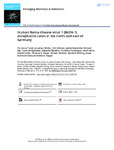2021-12-21Zeitschriftenartikel
Human Borna disease virus 1 (BoDV-1) encephalitis cases in the north and east of Germany
Frank, Christina
Wickel, Jonathan
Brämer, Dirk
Matschke, Jakob
Ibe, Richard
Gazivoda, Caroline
Günther, Albrecht
Hartmann, Christian
Rehn, Kordt
Cadar, Daniel
Mayer, Thomas E.
Pörtner, Kirsten
Wilking, Hendrik
Schmidt-Chanasit, Jonas
Tappe, Dennis
In 2021, three encephalitis cases due to the Borna disease virus 1 (BoDV-1) were diagnosed in the north and east of Germany. The patients were from the states of Thuringia, Saxony-Anhalt, and Lower Saxony. All were residents of known endemic areas for animal Borna disease but without prior diagnosed human cases. Except for one recently detected case in the state of Brandenburg, all >30 notified cases had occurred in, or were linked to, the southern state of Bavaria. Of the three detected cases described here, two infections were acute, while one infection was diagnosed retrospectively from archived brain autopsy tissue samples. One of the acute cases survived, but is permanently disabled. The cases were diagnosed by various techniques (serology, molecular assays, and immunohistology) following a validated testing scheme and adhering to a proposed case definition. Two cases were classified as confirmed BoDV-1 encephalitis, while one case was a probable infection with positive serology and typical brain magnetic resonance imaging, but without molecular confirmation. Of the three cases, one full virus genome sequence could be recovered. Our report highlights the need for awareness of a BoDV-1 etiology in cryptic encephalitis cases in all areas with known animal Borna disease endemicity in Europe, including virus-endemic regions in Austria, Liechtenstein, and Switzerland. BoDV-1 should be actively tested for in acute encephalitis cases with residence or rural exposure history in known Borna disease-endemic areas.
Dateien zu dieser Publikation

